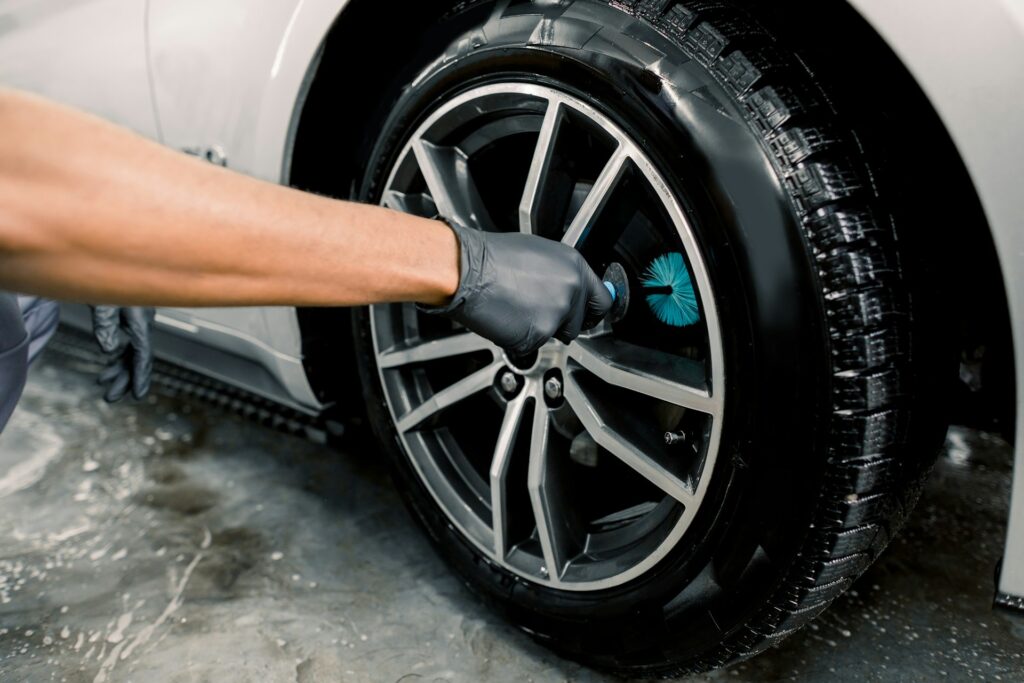All over the country, tyres are coming in for more and more punishment from less well-maintained roads. Although National Highways is responsible for most arterial roads in the UK, local authorities from Monmouthshire to Moray and from Flintshire to Fife are supposed to keep smaller roads pothole-free. This isn’t always the case, unfortunately, as anyone who has smashed their scalp into the roof of their car after bouncing off one will attest.
With potholes proliferating, it’s never been more pressing to ensure your tyres are ship-shape and roadworthy. Discover here what the experts say about tyre care wherever you drive in the UK and beyond.
Look At Your Tyres
To begin with, a careful once-over of your tyres is a necessary first step in taking good care of them. Many motorists simply fail in this basic aspect of tyre maintenance.
Look out for the most obvious signs of damage, such as cuts, bulges, punctures or embedded objects, such as thorns. These types of problems can seem benign but end up causing much worse situations when they could’ve been relatively simple to resolve before you get behind the wheel. Regular inspections will help you spot damage early and take action to prevent blowouts and, more seriously, accidents.
Read: 5 IDEAL tips for keeping your tyres healthy

Confirm Tread Depth
Sufficient tyre tread is essential if you are to drive safely. What’s more, it is the law. Throughout the UK, the minimum legal tread depth is about the same as the rim of a twenty-pence coin, or 1.6mm.
If your tread is allowed to dip below this level anywhere in the middle part of the tyre, then you’d be breaking the law by driving on it on a public road. Regardless of your legal obligations, adequate tread means being able to maintain good traction on the road, particularly in rainy conditions or when there’s standing water left on the tarmac following a downpour.
Check Tyre Pressure
Something that is crucial for any vehicle’s performance is the tyre pressure that is maintained by the driver. Each car will have the tyre pressure level you should set that’ll be listed in the driver’s side door jamb or the owner’s manual.
Under-inflated tyres can result in increased fuel consumption and the inability to stop when you need to, not to mention the inability to swerve out of the way of hazards effectively. Similarly, tyres that have been pumped up too much will often see greater wear while being more prone to damage from imperfections in the road’s surface. It’s essential, then, to regularly check your tyre pressure.

Unusual Wear
Uneven or unusual tyre wear can be a sign of more than one problem. Improper tyre inflation, misaligned wheels or suspension failures can all result in strange wear patterns. If left unaddressed, uneven wear can lead to compromised car handling among other unwanted issues. Most tyre professionals would recommend having your tyres and vehicle inspected by a technician when uneven rates of tyre wear have been detected.
Spare Tyre Checks
Spare tyres are frequently ignored by motorists, even when they’re not driving their own car and have, perhaps, hired one instead. However, the spare is just as important as the others if you end up needing to fit it. Make sure yours is properly inflated, for example. A spare tyre that is in poor condition or that is a little flat may cause as many problems as a damaged road tyre. After all, the last thing you want is to fit your spare at the side of the road only for it to fail a few miles down the road.
Although there is no legal obligation to carry a spare tyre, it is highly recommended so always look to see if there is one before setting off in a car you don’t know.
Rotate Your Tyres Regularly
Even with perfect road conditions, tyres will naturally wear at different rates depending on their position on your vehicle. Front tyres on front-wheel-drive cars, for instance, typically wear faster than those at the rear. Rotating your tyres every 5,000 to 8,000 miles helps distribute wear more evenly, ultimately extending their lifespan and saving you money in the long run.
Many motorists overlook this simple maintenance step, but tyre rotation is something that can easily be done during a routine service. Some garages will even offer this as a complimentary service when you’re having other work done. If you’re unsure about the correct rotation pattern for your vehicle, consult your owner’s manual or speak with a qualified tyre specialist.

Consider Seasonal Tyres
British weather is notoriously changeable, and this has significant implications for tyre performance. While all-season tyres are a popular choice for many UK drivers, there are compelling reasons to consider seasonal alternatives depending on where you live and the conditions you typically drive in.
Winter tyres, with their specialised tread patterns and softer rubber compounds, provide superior grip when temperatures drop below 7°C. They’re particularly effective in snow and ice, conditions that can bring parts of the UK to a standstill each winter. Conversely, summer tyres offer optimal performance in warmer conditions, with better handling and shorter braking distances on dry and wet roads during milder months.
For those in highland areas of Scotland, rural Wales, or other regions prone to severe winter weather, investing in a set of winter tyres for the colder months could be a wise safety decision. Meanwhile, performance-oriented drivers might prefer the responsive handling of summer tyres during warmer periods. Whichever you choose, ensuring your tyres are appropriate for the conditions you’re driving in is paramount for both safety and vehicle performance.
The Bottom Line
Taking care of your tyres isn’t just about compliance with the law – it’s about ensuring your safety and that of other road users. Regular checks of tread depth, pressure, wear patterns and overall condition should be part of every motorist’s routine, particularly with the deteriorating state of Britain’s roads. Remember that your tyres are the only point of contact between your vehicle and the road; neglecting them means compromising on control, fuel efficiency and overall driving experience.
Whether you’re navigating the pothole-riddled streets of urban centres or cruising along motorways, healthy tyres can make all the difference in how your vehicle performs. By following these seven expert tips – from visual inspections to seasonal considerations – you’ll not only extend the life of your tyres but also significantly enhance your driving safety.
Should you discover an issue that needs immediate attention but lack the time to visit a garage, mobile tyre fitting services offer a convenient solution. These professionals come to your location – whether at home, work, or even roadside – with all the necessary equipment to replace or repair your tyres on the spot. It’s particularly handy for those with busy schedules or when you find yourself with a damaged tyre in an inconvenient location.
A modest investment of time in tyre maintenance today could well prevent a costly replacement or, more importantly, a dangerous situation tomorrow.
Of course, healthy tyres are only one part of proper car care. For a more comprehensive look at things, check out our ultimate car repair and maintenance guide. Because safety should always come first!





